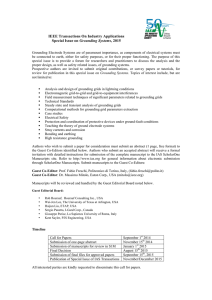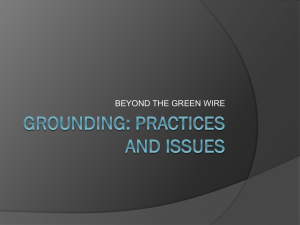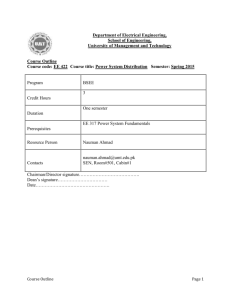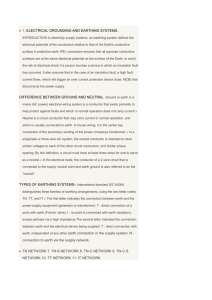section 260526 – grounding and bonding for electrical systems
advertisement
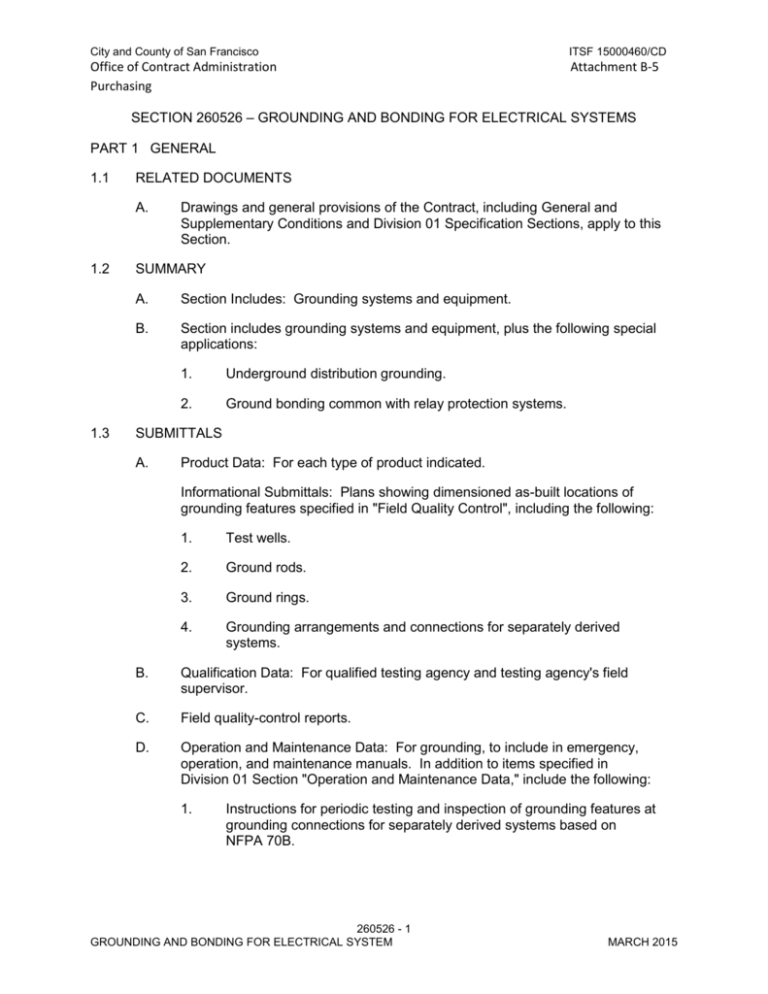
City and County of San Francisco ITSF 15000460/CD Office of Contract Administration Purchasing Attachment B-5 SECTION 260526 – GROUNDING AND BONDING FOR ELECTRICAL SYSTEMS PART 1 GENERAL 1.1 RELATED DOCUMENTS A. 1.2 1.3 Drawings and general provisions of the Contract, including General and Supplementary Conditions and Division 01 Specification Sections, apply to this Section. SUMMARY A. Section Includes: Grounding systems and equipment. B. Section includes grounding systems and equipment, plus the following special applications: 1. Underground distribution grounding. 2. Ground bonding common with relay protection systems. SUBMITTALS A. Product Data: For each type of product indicated. Informational Submittals: Plans showing dimensioned as-built locations of grounding features specified in "Field Quality Control", including the following: 1. Test wells. 2. Ground rods. 3. Ground rings. 4. Grounding arrangements and connections for separately derived systems. B. Qualification Data: For qualified testing agency and testing agency's field supervisor. C. Field quality-control reports. D. Operation and Maintenance Data: For grounding, to include in emergency, operation, and maintenance manuals. In addition to items specified in Division 01 Section "Operation and Maintenance Data," include the following: 1. Instructions for periodic testing and inspection of grounding features at grounding connections for separately derived systems based on NFPA 70B. 260526 - 1 GROUNDING AND BONDING FOR ELECTRICAL SYSTEM MARCH 2015 City and County of San Francisco ITSF 15000460/CD Office of Contract Administration Purchasing Attachment B-5 1.4 a. Tests shall determine if ground-resistance or impedance values remain within specified maximums, and instructions shall recommend corrective action if values do not. b. Include recommended testing intervals. QUALITY ASSURANCE A. Testing Agency Qualifications: Member company of NETA or an NRTL. 1. Testing Agency's Field Supervisor: Currently certified by NETA to supervise on-site testing. B. Electrical Components, Devices, and Accessories: Listed and labeled as defined in NFPA 70, by a qualified testing agency, and marked for intended location and application. C. Comply with UL 467 for grounding and bonding materials and equipment. PART 2 PRODUCTS 2.1 CONDUCTORS A. Insulated Conductors: Copper wire or cable insulated for 600 V unless otherwise required by applicable Code or authorities having jurisdiction. B. Bare Copper Conductors: C. 1. Solid Conductors: ASTM B 3. 2. Stranded Conductors: ASTM B 8. 3. Tinned Conductors: ASTM B 33. 4. Bonding Cable: 28 kcmil, 14 strands of No. 17 AWG conductor, 1/4 inch in diameter. 5. Bonding Conductor: No. 4 or No. 6 AWG, stranded conductor. 6. Bonding Jumper: Copper tape, braided conductors terminated with copper ferrules; 1-5/8 inches wide and 1/16 inch thick. 7. Tinned Bonding Jumper: Tinned-copper tape, braided conductors terminated with copper ferrules; 1-5/8 inches wide and 1/16 inch thick. Grounding Bus: Predrilled rectangular bars of annealed copper, 1/4 by 4 inches in cross section, with 9/32-inch holes spaced 1-1/8 inches apart. Stand-off insulators for mounting shall comply with UL 891 for use in switchboards, 600 V. Lexan or PVC, impulse tested at 5,000 V. 260526 - 2 GROUNDING AND BONDING FOR ELECTRICAL SYSTEM MARCH 2015 City and County of San Francisco ITSF 15000460/CD Office of Contract Administration Purchasing Attachment B-5 2.2 CONNECTORS A. Listed and labeled by an NRTL acceptable to authorities having jurisdiction for applications in which used and for specific types, sizes, and combinations of conductors and other items connected. B. Bolted Connectors for Conductors and Pipes: Copper or copper alloy, pressure type with at least two bolts. 1. 2.3 Pipe Connectors: Clamp type, sized for pipe. C. Welded Connectors: Exothermic-welding kits of types recommended by kit manufacturer for materials being joined and installation conditions. D. Bus-bar Connectors: Mechanical type, cast silicon bronze, solderless compression type wire terminals, and long-barrel, two-bolt connection to ground bus bar. GROUNDING ELECTRODES A. Ground Rods: Copper-clad steel; ¾ inch in diameter by 10 feet. B. Chemical-Enhanced Grounding Electrodes: Copper tube, straight or L-shaped, charged with nonhazardous electrolytic chemical salts. 1. Termination: Factory-attached No. 4/0 AWG bare conductor at least 48 inches long. 2. Backfill Material: Electrode manufacturer's recommended material. PART 3 EXECUTION 3.1 APPLICATIONS A. Conductors: Install solid conductor for No. 10 AWG and smaller, and stranded conductors for No. 8 AWG and larger unless otherwise indicated. B. Underground Grounding Conductors: Install bare copper conductor, No. 2/0 AWG minimum. 1. Bury at least 24 inches below grade. 2. Duct-Bank Grounding Conductor: Bury at bottom of duct bank when indicated as part of duct-bank installation. C. Isolated Grounding Conductors: Where required, green-colored insulation with continuous yellow stripe. On feeders with isolated ground, identify grounding conductor where visible to normal inspection, with alternating bands of green and yellow tape, with at least three bands of green and two bands of yellow. D. Grounding Bus: Install in electrical and telephone equipment rooms, in rooms housing service equipment, and elsewhere as indicated. 260526 - 3 GROUNDING AND BONDING FOR ELECTRICAL SYSTEM MARCH 2015 City and County of San Francisco ITSF 15000460/CD Office of Contract Administration Purchasing Attachment B-5 E. 3.2 3.3 1. Install bus on insulated spacers 2 inches minimum from wall, 6 inches above finished floor unless otherwise indicated. 2. Where indicated on both sides of doorways, route bus up to top of door frame, across top of doorway, and down to specified height above floor; connect to horizontal bus. Conductor Terminations and Connections: 1. Pipe and Equipment Grounding Conductor Terminations: Bolted connectors. 2. Underground Connections: Welded connectors except at test wells and as otherwise indicated. 3. Connections to Ground Rods at Test Wells: Bolted connectors. 4. Connections to Structural Steel: Welded connectors. GROUNDING UNDERGROUND DISTRIBUTION SYSTEM COMPONENTS A. Comply with IEEE C2 grounding requirements. B. Grounding Manholes and Handholes: Install a driven ground rod through manhole or handhole floor, close to wall, and set rod depth so 4 inches will extend above finished floor. If necessary, install ground rod before manhole is placed and provide No. 1/0 AWG bare, tinned-copper conductor from ground rod into manhole through a waterproof sleeve in manhole wall. Protect ground rods passing through concrete floor with a double wrapping of pressure-sensitive insulating tape or heat-shrunk insulating sleeve from 2 inches above to 6 inches below concrete. Seal floor opening with waterproof, nonshrink grout. C. Grounding Connections to Manhole Components: Bond exposed-metal parts such as inserts, cable racks, pulling irons, ladders, and cable shields within each manhole or handhole, to ground rod or grounding conductor. Make connections with No. 4 AWG minimum, stranded, hard-drawn copper bonding conductor. Train conductors level or plumb around corners and fasten to manhole walls. Connect to cable armor and cable shields according to written instructions by manufacturer of splicing and termination kits. D. Pad-Mounted Transformers and Switches: Install two ground rods and a ground ring around the pad. Ground pad-mounted equipment and noncurrent-carrying metal items associated with substations by connecting them to underground cable and grounding electrodes. Install tinned-copper conductor not less than No. 2 AWG for ground ring and for taps to equipment grounding terminals. Bury ground ring not less than 6 inches from the foundation. EQUIPMENT GROUNDING A. Install insulated equipment grounding conductors with all feeders and branch circuits. 260526 - 4 GROUNDING AND BONDING FOR ELECTRICAL SYSTEM MARCH 2015 City and County of San Francisco ITSF 15000460/CD Office of Contract Administration Purchasing Attachment B-5 B. 3.4 Install insulated equipment grounding conductors with the following items, in addition to those required by NFPA 70: 1. Feeders and branch circuits. 2. Lighting circuits. 3. Receptacle circuits. 4. Single-phase motor and appliance branch circuits. 5. Three-phase motor and appliance branch circuits. 6. Flexible raceway runs. 7. Armored and metal-clad cable runs. 8. Busway Supply Circuits: Install insulated equipment grounding conductor from grounding bus in the switchgear, switchboard, or distribution panel to equipment grounding bar terminal on busway. INSTALLATION A. Grounding Conductors: Route along shortest and straightest paths possible unless otherwise indicated or required by Code. Avoid obstructing access or placing conductors where they may be subjected to strain, impact, or damage. B. Ground Bonding Common with Lightning Protection System: Comply with NFPA 780 and UL 96 when interconnecting with lightning protection system. Bond electrical power system ground directly to lightning protection system grounding conductor at closest point to electrical service grounding electrode. Use bonding conductor sized same as system grounding electrode conductor, and install in conduit. C. Ground Rods: Drive rods until tops are 2 inches below finished floor or final grade unless otherwise indicated. D. 1. Interconnect ground rods with grounding electrode conductor below grade and as otherwise indicated. Make connections without exposing steel or damaging coating if any. 2. For grounding electrode system, install at least three rods spaced at least one-rod length from each other and located at least the same distance from other grounding electrodes, and connect to the service grounding electrode conductor. Test Wells: Ground rod driven through drilled hole in bottom of handhole. Handholes are specified in Section 33 70 02 "Electrical Distribution System, Underground" and shall be at least 12 inches deep, with cover. 260526 - 5 GROUNDING AND BONDING FOR ELECTRICAL SYSTEM MARCH 2015 City and County of San Francisco ITSF 15000460/CD Office of Contract Administration Purchasing Attachment B-5 1. E. F. G. 3.5 Bonding Straps and Jumpers: Install in locations accessible for inspection and maintenance except where routed through short lengths of conduit. 1. Bonding to Structure: Bond straps directly to basic structure, taking care not to penetrate any adjacent parts. 2. Bonding to Equipment Mounted on Vibration Isolation Hangers and Supports: Install bonding so vibration is not transmitted to rigidly mounted equipment. 3. Use exothermic-welded connectors for outdoor locations; if a disconnecttype connection is required, use a bolted clamp. Ground Ring: Install a grounding conductor, electrically connected to each equipment ground rod extending around the perimeter of equipment. 1. Install tinned-copper conductor not less than No. 2/0 AWG for ground ring and for taps to building steel. 2. Bury ground ring not less than 24 inches from equipment's foundation. Ufer Ground (Concrete-Encased Grounding Electrode): Fabricate according to NFPA 70; use a minimum of 20 feet of bare copper conductor not smaller than No. 4/0 AWG. 1. If concrete foundation is less than 20 feet long, coil excess conductor within base of foundation. 2. Bond grounding conductor to reinforcing steel in at least four locations and to anchor bolts. Extend grounding conductor below grade and connect to building's grounding grid or to grounding electrode external to concrete. LABELING A. Comply with requirements in Division 26 Section "Identification for Electrical Systems" Article for instruction signs. The label or its text shall be green. B. Install labels at the telecommunications bonding conductor and grounding equalizer, and at the grounding electrode conductor where exposed. 1. 3.6 Test Wells: Install at least one test well for each service unless otherwise indicated. Install at the ground rod electrically closest to service entrance. Set top of test well flush with finished grade or floor. Label Text: "If this connector or cable is loose or if it must be removed for any reason, notify the facility manager." FIELD QUALITY CONTROL A. Testing Agency: Engage qualified testing personnel to perform tests and inspections. 260526 - 6 GROUNDING AND BONDING FOR ELECTRICAL SYSTEM MARCH 2015 City and County of San Francisco ITSF 15000460/CD Office of Contract Administration Purchasing Attachment B-5 B. Tests and Inspections: 1. After installing grounding system but before permanent electrical circuits have been energized, test for compliance with requirements. 2. Inspect physical and mechanical condition. Verify tightness of accessible, bolted, electrical connections with a calibrated torque wrench according to manufacturer's written instructions. 3. Test completed grounding system at each location where a maximum ground-resistance level is specified, at service disconnect enclosure grounding terminal, at ground test wells, and at individual ground rods. Make tests at ground rods before any conductors are connected. 4. a. Measure ground resistance no fewer than two full days after last trace of precipitation and without soil being moistened by any means other than natural drainage or seepage and without chemical treatment or other artificial means of reducing natural ground resistance. b. Perform tests by fall-of-potential method according to IEEE 81. Prepare dimensioned Drawings locating each test well, ground rod and ground-rod assembly, and other grounding electrodes. Identify each by letter in alphabetical order, and key to the record of tests and observations. Include the number of rods driven and their depth at each location, and include observations of weather and other phenomena that may affect test results. Describe measures taken to improve test results. C. Grounding system will be considered defective if it does not pass tests and inspections. D. Prepare test and inspection reports. E. Report measured ground resistances that exceed the following values: F. 1. Power Distribution Units or Panelboards Serving Electronic Equipment: 3 ohm(s). 2. Substations and Pad-Mounted Equipment: 5 ohms. 3. Manhole Grounds: 10 ohms. Excessive Ground Resistance: If resistance to ground exceeds specified values, notify Architect promptly and include recommendations to reduce ground resistance. END OF SECTION 260526 260526 - 7 GROUNDING AND BONDING FOR ELECTRICAL SYSTEM MARCH 2015

